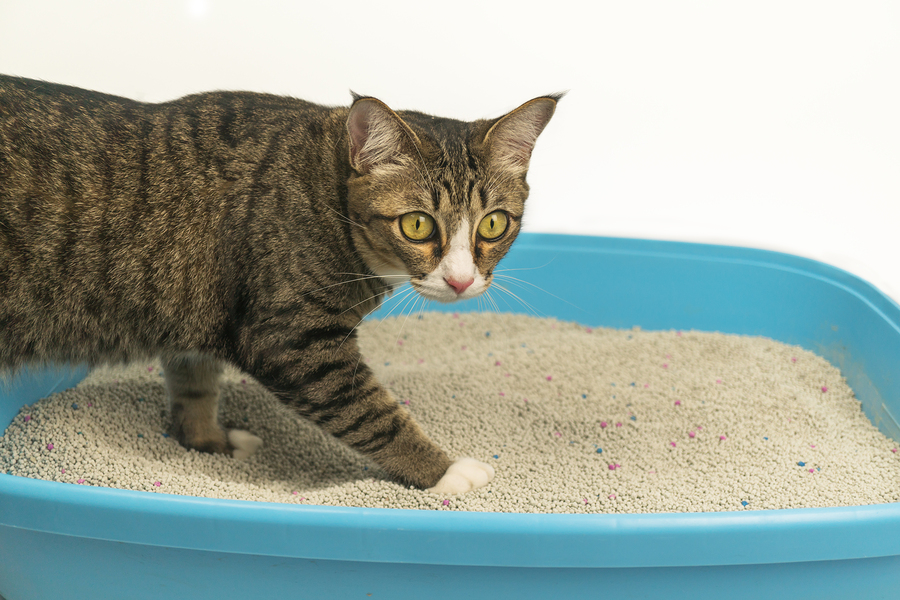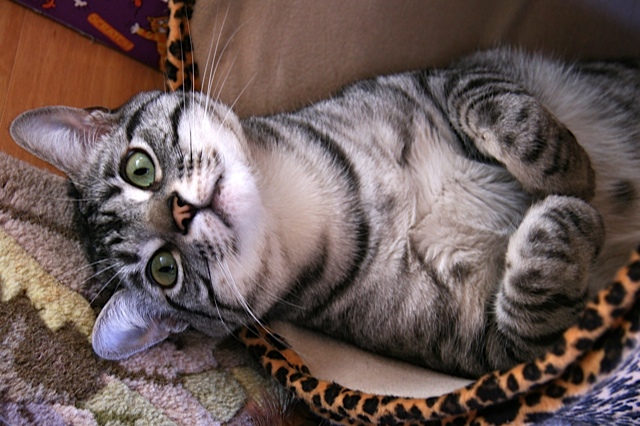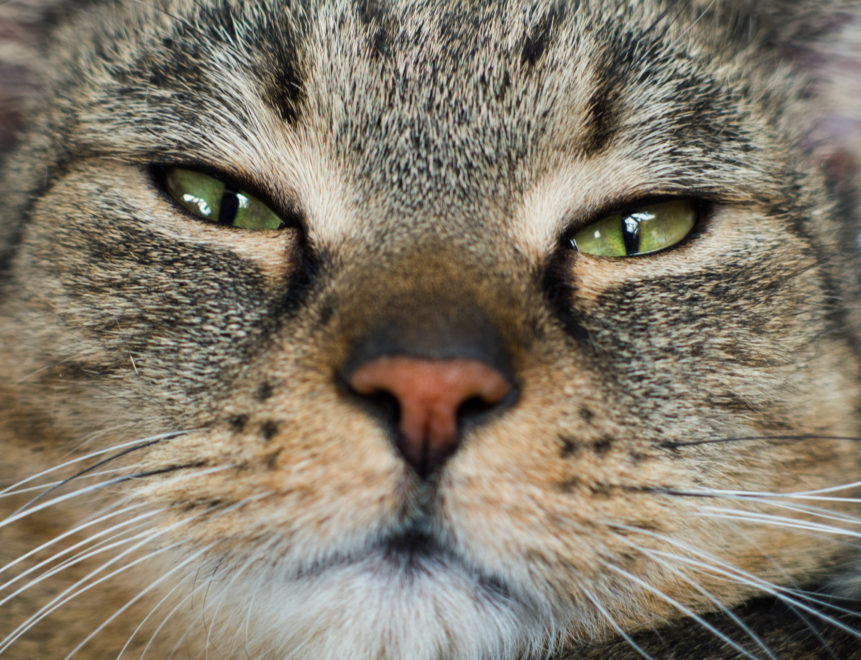
Catbox Issues: How to Get Your Cat to Go Inside the Catbox
Kitty Naughty Potty: Causes and Cures

Having trouble getting your cat to go in the catbox?
FELINE INAPPROPRIATE URINATION:
Most households want their cats to use the litter box. So urinating on the couch, bed, wall, rugs, and ceramic tile, or in the bathtub, laundry basket, or kitchen sink is just not appropriate! And that’s what we mean by “inappropriate urination.”
Inappropriate urination is, unfortunately, too common. All of us have known of cats with this unwanted habit. Many get labeled as lost causes. But we can help the vast majority of these cats. With a little detective work, the underlying cause can be found. Uncover the cause, implement the fix, and voila!
There is Always A Message In Outside the Box Eliminating
Consider inappropriate urination a message from the cat. Something is wrong and the cat is letting you know. The cat is not ‘acting out’, but asking for help. I have yet to meet a cat that did not, as a kitten, use a litter box. I have taken in feral cats and kittens ranging in age from one day to many years, and each and everyone has used a litter box. Even the youngest, motherless kitten will rapidly grasp the use of a litter box when placed in one. This is because cats have a natural affinity for sandy substrates. They want to dig in soil before they eliminate. They do not naturally choose flat, smooth, or cloth-like surfaces.

cute cat
Every cat is different and that’s why it’s helpful for me to tune into your cat to see what’s happening.
Suzan Vaughn
When Things Go Wrong
So if cats naturally use a litter box, and then decide to stop, something must have gone wrong. The cats are not spiteful, angry, or mean; something has gone awry. The list of problems that can push a cat out of the litter box and towards inappropriate urination is a long and potentially complicated one.
Is it Medical, Management, or Behavioral?

Sometimes it’s Medical
Medical reasons include any illness or disease that causes the cat to be in pain or increases urine production. So a bladder infection, with accompanying urinary tract pain, can certainly cause the cat to associate the box with the pain and lead to urination outside of the box. Other causes of pain might include bladder stones, inflammation, or tumors, as well as arthritis, muscle disease, or spinal cord pain that interferes with movement in and out of the box. All painful incidences associated with the box may result in failure to use it. Additional medical causes would include cognitive diseases that impair the mental abilities of older cats.
A final category of medical illnesses include all those that lead to increased urine production, such as kidney disease, diabetes, and thyroid problems. The greater the urine production, the more often the cat must urinate. This upsets the cat’s routine and soils the box more rapidly than expected, ultimately causing the cat to abandon the box.
See Your Veterinarian
Inappropriate urination may be the cat’s only notice to you that the he is sick. Heed the warning and rule out medical causes before blaming the cat for ‘bad behavior’.
Keepin’ it Clean
Another major cause of inappropriate urination is poor litter box management which results in cats having an aversion to the box, the litter, or the location. These cats may then develop a preference for a different location or surface. Litter box problems can be about boxes that are too small, too few, too dirty, left in incorrect places, or filled with litter. If the box feels or smells bad to the cat, that’s also an issue. No cat likes a small, dirty, noisy box.
Different cats have different needs. Some cats need boxes with low sides or high sides or ones that are open-sided or covered with a lid. Some have aversions to scented litter, or clumping litter, or unscented litter, or the chemicals in the plastic box. So buying the smallest, covered box for a 15-pound cat will not work. Neither will buy the deepest, self-cleaning box for a timid, 1.5-pound kitten. And putting a box down two flights of stairs may invite trouble from a 19-year-old arthritic cat.
Interruptions
While we are on the subject of boxes, litter, and locations, I can pretty well guarantee that you can cause inappropriate urination by putting a litter box next to a washing machine that hits the spin cycle just at the cat tries to use the box. A litter pan near a washing machine or dryer is an invitation for disaster.
To prevent litter box aversion, make sure your cat likes her box. Identify your cat’s needs and meet them. Trial and error may be needed to find the appropriate mix of box, litter, and location; but it’s worth the effort in the long run. Litter type, depth, and fragrance are all variables that can be adjusted. So try different types of litter, including clumping and non-clumping, scented and non-scented, and litters made of wheat or paper. Also, experiment with covered and uncovered boxes, self-cleaning litter trays, and round or rectangular pans.
Multiple Boxes
Purchase multiple boxes for multi-cat households. The rule of thumb is one box per cat, plus one extra box. So a household with four cats need five boxes, preferably in separate locations. This may sound excessive, but it is much easier to manage the boxes than a cat urinating on the pillows! If may even be necessary to have different types of boxes and different litters for the different cats.
Litter Cleanliness
Lack of litter cleanliness is a significant cause of inappropriate urination. Cats do NOT like dirty litter boxes. Their noses work much better than human noses, so they can detect unpleasant odors that people ignore. Some cats are so offended by dirty litter that they will even avoid boxes used by other cats. Others will try to keep their bodies out of the box and urinate over the edge. Still others will gingerly step in the box and then
urinate out of it, or urinate just next to the box. These cats are telling you very clearly that they do not like the litter in the box. They are attempting to use the pan, but are just too repulsed by the litter to use it appropriately. If the situation is not remedied rapidly, these cats may soon avoid the entire litter box.
Heeding the cat’s pleas can help prevent inappropriate urination. The litter pans must be as clean as possible. Scoop daily at minimum and preferably every time the box is used. I realize that everyone knows of an owner that only cleans boxes once per week and the cats are just fine. Do not assume this will work for your cat and do not get comfortable with this system. At any time an individual cat may react to a filthy litter pan by choosing to urinate outside of the box. It is easier to prevent the problem with frequent cleanings than to attempt to remedy it.
Plastic litter boxes also hold odors, so boxes should be dumped and washed out weekly. Use a mild detergent, rinse thoroughly, and then dry the box before refilling. The pans may even need to be replaced periodically, as it is impossible to get rid of the accumulated odors that eventually permeate the plastic. Actually, this is a good reason to avoid saving old litter boxes from previous cats for new arrivals. The new cat can still detect the odors from the old cat and may refuse to use the old box. So, the second rule of thumb is that new cats should always get new litter boxes.
Litter Box Aversion
Litter box aversion can be prevented with proper planning. Start off correctly by purchasing fine, unscented litter and placing it one to two inches deep in a clean box. Most cats like large, uncovered boxes, as the odors are not trapped in the box and the cat can see out of the box. Place the box in a quiet area that is separated from the food area and away from machinery. Pick quiet, easy-to-access locations. Avoid damp, dank spots (wet basements) that hold odors and keep the litter moist. Avoid litter box liners, if possible, as many cats dislike them. Keep the box clean and dry, change the litter as needed, and make sure that all the cats have easy access to all the boxes.
Ingrained Behavior
Behavioral causes need to be explored if all litter box management and medical issues are handled. It this is the case, it is important to seek help quickly. The longer the problem continues, the more difficult it is to treat and the longer the problem takes to resolve. Cats will rapidly develop preferences for inappropriate places because the surface and location are more pleasing than the litter pan. The problem then becomes more difficult to solve, as the cat now has both a behavioral issue and a preference for the wrong spot.
Behavioural & Psychological Issues
- Behavioral issues are as varied as cats.
- Example of behavioral issues: a cat that is too frightened to use the box because other cats or dogs terrorize her in or out of the box.
- A cat that suddenly becomes territorial when he sees a stray cat outside. He may urinate near the door.
- The why of this is extremely varied. You may need help from outside sources like animal communication Specialist Suzan Vaughn, veterinarians, and board-certified veterinary behaviorists.
Backing Away from the Box
When antique furniture or old carpets stained with urine from previous animals are brought into the house, cats often stop using their box. Others are upset by new pets, new adults, or new babies. Some are reacting to tension or fighting within the household. The list goes on and on.
Fixes
Treatment relates to the specific cause and can be a simple as adding additional litter boxes, closing the blinds so a cat cannot see outside, or getting rid of old, soiled furniture and carpets.
Others standard ‘fixes’ include using enzyme cleaners to clean up any accidents and remove odors. In addition, it is helpful to cover inappropriate areas with plastic carpet runners, sheets of plastic, tin foil, or other items with textures that the cats find unappealing. Make sure to close doors to keep cats away from rooms and furniture they wish to use as litter boxes.
Cover the bases of plants with tinfoil or wire mesh to keep out curious cats. The use of soothing pheromones, such as Feliway, may also be helpful for cats suffering from anxiety. Some cats also respond positively to special litter attracting agents made from soil and herbs. Finally, some cats need anti-anxiety medications available from veterinarians.
NOT a punishable offense
Hitting, screaming, and rubbing the cat’s nose on the soiled areas is ineffective and inhumane. These actions will increase the cat’s anxiety, teach it to run from you, and most likely make the problem worse. The cat will not connect your behaviors with his actions and simply learn to avoid you, along with the litter box. In addition, your behavior may increase the cat’s nervousness and create additional troubles. If your cat is urinating inappropriately, seek creative management solutions, not punishments.
Spraying
A similar, but different problem involves cats that spray. The issue with these cats is not the use of the litter box, but urine marking. Cats that spray inappropriately deposit small drops of urine in a specific area. Usually, they are standing when they do this and back up to a spot, wiggle their tail, and release small amounts of urine on vertical surfaces. Cats that spray are communicating with other cats. They may be announcing their presence, making or keeping their territories, or looking for a mate.
Because spraying is a territorial sign, the incidence of this behavior goes up in multi-cat households or houses with feral cats roaming the yard. So a new cat, baby, roommate, furniture, or even carpeting may trigger spraying. Illness, lack of appropriate exercise, isolation, and inactivity may also lead to spraying.
Treatment for Spraying
Treatment for spraying is similar to that for inappropriate urination, with one notable exception. Since hormonal influences drive intact male cats to spray, any intact male cat that sprays should be neutered immediately. Other treatments include separating the cat from the preferred spraying area, covering the area with plastic or tinfoil, and the use of pheromones or medications to ease anxiety.
You cannot make a house bigger. But you can increase the space each cat calls his own. Make room vertically by clearing off shelves and adding cat furniture that allows the cat to climb up. Add horizontal hiding places with boxes, a few open drawers or closets, and cat furniture. Anything that allows the cat to move into more areas will decrease pressure to defend the territory and may reduce spraying.
Every Cat is Different
The bottom line is that a variety of environmental, behavioral, and medical causes can lead to inappropriate urination and/or spraying. It is up to the owner to take immediate action to uncover the cause, eliminate it, and take appropriate steps to get the cat back into the box. This may take time, consultation with professionals, changes in household management, and considerable effort.
Dr. Jane Leon is the original writer of this piece, but it has been changed to fit a writing style Google likes better.
Another Great Article
LESSONS FROM THE CAT: LITTER BOX BASICS FOR THE VETERINARY TEAM
by Rachel Lees, RVT, KPA CTP, VTS (Behavior)
